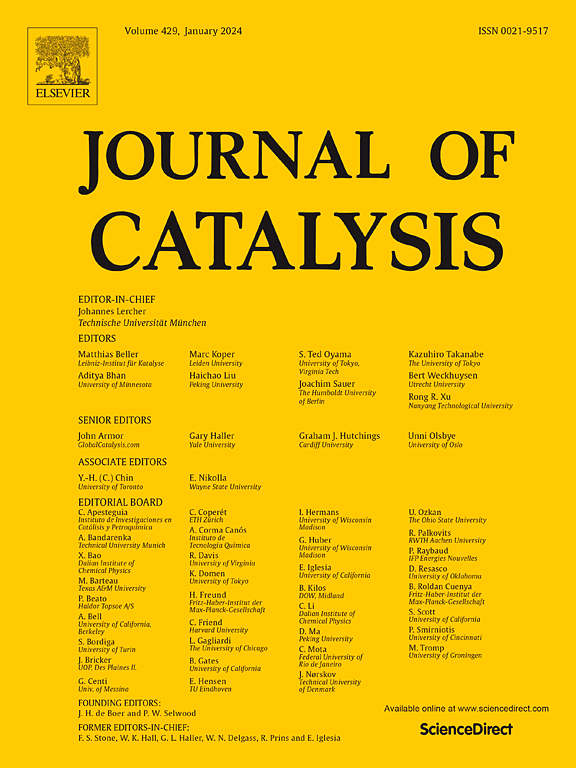乙烷在RhO2上选择性转化为增值产品:DFT和微动力学模拟研究
IF 6.5
1区 化学
Q2 CHEMISTRY, PHYSICAL
引用次数: 0
摘要
由于小烷烃具有强烈的完全氧化倾向,因此将其选择性地转化为高附加值产品是催化领域的一项重大挑战。在本研究中,我们采用 DFT 计算和 TPRS 模拟来研究乙烷在 RhO2(1 1 0) 表面的氧化作用。我们的研究结果表明,RhO2(1 1 0) 的适度反应性提高了乙烯生产的选择性,使 RhO2(1 1 0) 成为一种很有前途的催化剂,可用于小烷烃的选择性氧化并提高高附加值产品的产量。除 RhO2 外,我们还提出,高活性过渡金属氧化物表面也可能表现出类似的 C2H4 解吸机制,包括基于 C2H4 重整的解吸,这一点可通过与高活性 IrO2 的比较得到支持。这一见解表明,旨在促进 C2H4 重整反向反应的催化策略有可能促进活性过渡金属氧化物上 C2H6 氧化产生 C2H4(g)。本文章由计算机程序翻译,如有差异,请以英文原文为准。

Selective conversion of ethane to value added products on RhO2(1 1 0): A DFT and microkinetic simulation study
The selective conversion of small alkanes into value-added products presents a significant challenge in catalysis due to the strong tendency toward complete oxidation. In this study, we employed DFT calculations and TPRS simulations to investigate ethane oxidation on the RhO2(1 1 0) surface. Our results demonstrate that the moderate reactivity of RhO2(1 1 0) enhances selectivity for ethylene production, positioning RhO2(1 1 0) as a promising catalyst for the selective oxidation of small alkanes and improved yields of value-added products. Extending beyond RhO2, we propose that highly reactive transition metal oxide surfaces may exhibit similar C2H4 desorption mechanisms involving C2H4 reformation-based desorption, as supported by comparisons with highly active IrO2. This insight suggests that catalytic strategies designed to facilitate reverse reactions for C2H4 reformation hold potential for boosting C2H4(g) production from C2H6 oxidation on active transition metal oxides.
求助全文
通过发布文献求助,成功后即可免费获取论文全文。
去求助
来源期刊

Journal of Catalysis
工程技术-工程:化工
CiteScore
12.30
自引率
5.50%
发文量
447
审稿时长
31 days
期刊介绍:
The Journal of Catalysis publishes scholarly articles on both heterogeneous and homogeneous catalysis, covering a wide range of chemical transformations. These include various types of catalysis, such as those mediated by photons, plasmons, and electrons. The focus of the studies is to understand the relationship between catalytic function and the underlying chemical properties of surfaces and metal complexes.
The articles in the journal offer innovative concepts and explore the synthesis and kinetics of inorganic solids and homogeneous complexes. Furthermore, they discuss spectroscopic techniques for characterizing catalysts, investigate the interaction of probes and reacting species with catalysts, and employ theoretical methods.
The research presented in the journal should have direct relevance to the field of catalytic processes, addressing either fundamental aspects or applications of catalysis.
 求助内容:
求助内容: 应助结果提醒方式:
应助结果提醒方式:


